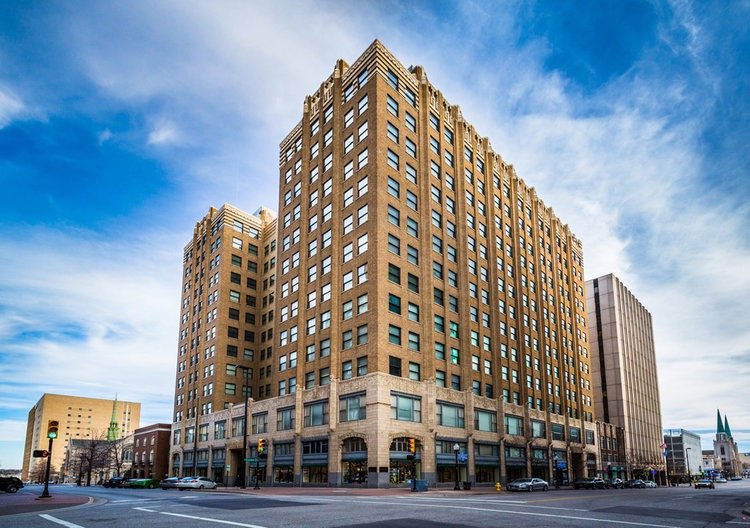
Audio Tour Coming Soon!
A. Philcade Building - 1931
501 S. Boston Avenue
The Philcade Building, designed by Leon B. Senter for oil magnate Waite Phillips and completed in 1931 at 5th & Boston, is a striking example of Tulsa’s Zigzag Art Deco style. Originally intended as a six-story office-and-arcade complex, its structure was revised mid-construction to stand 13 stories tall with an additional penthouse added in 1936 by local general contractor W.R. Grimshaw, renowned for his expertise in adapting large-scale commercial projects to the evolving ambitions of Tulsa’s oil-era elite. Its T-shaped lobby, celebrated as Tulsa’s first indoor retail arcade, dazzles with glazed terra cotta featuring hidden fauna, a gold‑leaf vaulted ceiling, bronze chandeliers, marble pilasters, and terrazzo floors. Listed on the National Register of Historic Places in 1986, the Philcade remains a jewel of downtown Tulsa and a showcase of early 20th-century architectural ambition.
B. Tulsa Club - 1927
115 E. 5th Street
The Tulsa Club Building, now operating as the Tulsa Club Hotel, is an 11-story Art Deco landmark at Fifth and Cincinnati. Originally constructed in 1927 by Bruce Goff with Rush, Endacott and Rush for the Tulsa Club and Chamber of Commerce, this architectural gem featured lavish interiors, including mosaic fireplaces, a rooftop Sky Terrace ballroom, a gym, and barbershop amenities. It served Tulsa’s oil industry elite until its closure in 1994. After decades of vacancy, vandalism, and fires, the Ross Group and Promise Hotels invested $36 million to restore and reopen the building in 2019 as a 96-room boutique hotel in Hilton’s Curio Collection, preserving its historic charm while adding modern hospitality features.
C. Southwestern Main Dial - 1930
424 S Detroit Avenue
The Southwestern Bell Main Dial Building, located at Fifth Street and Detroit Avenue, was originally a two-story Gothic Revival structure built in 1924 to house Tulsa’s first automatic telephone dialing equipment. In 1930, a four-story Zigzag Art Deco addition was seamlessly integrated atop the original shell to accommodate expanding equipment and offices. The expansion features buff-colored terra cotta ornamentation and stepped-back pinnacles.
D. ARCO Building - 1950
119 E. 6th Street
The ARCO Building, officially known as the former Service Pipeline Company Building and later the Stanolind or Amoco East Building, is a six‑story Streamline Moderne/Art Deco gem erected in 1950 at the corner of Sixth Street and Cincinnati Avenue in Tulsa’s Deco District. Designed by Leon B. Senter & Associates, the building features signature mid‑century and streamline art deco details like marble‑accented lobbies, geometric exterior ornamentation, and sleek limestone and brick façade.
E. Oklahoma Natural Gas Building - 1929
624 S. Boston Avenue
The Oklahoma Natural Gas Company Building is a landmark Zigzag Art Deco skyscraper completed in 1925–29. Designed by Frank V. Kirshner and Arthur M. Atkinson, the reinforced concrete structure is clad in buff brick with a limestone base and ornate terra‑cotta detailing, its bold vertical piers and arched ground‑floor bays epitomize Tulsa’s early embrace of Art Deco. Recognized for its architectural significance, the building was spared demolition in 1982 and added to the National Register of Historic Places in 1984. Today, it remains a proud contributing structure in the Oil Capital Historic District, symbolizing the city’s 1920s boom and enduring architectural legacy.
F. Public Service Company - 1929
2 W. 6th Street
The original PSO Building is a 1929 Zigzag Art Deco landmark designed by Atkinson & Koberling. Known as the “Monument in Light,” it once housed electric showrooms and PSO’s headquarters. Now restored as the Art Deco Lofts & Apartments, it blends historic charm with modern living in the heart of downtown Tulsa.
G. Pythian Building
427 S. Boston Avenue
The Pythian Building is a striking Art Deco landmark completed in 1931. Originally envisioned as a 13-story hotel by oilmen Gillette and Tyrrell, construction halted at three stories due to the Great Depression. The Knights of Pythias acquired and finished the building, giving it its name. Clad in cream-colored terra cotta with pastel accents and diamond-patterned reliefs, the building features bold vertical lines and rich Deco details. Inside, the tiled lobby showcases Native American-inspired patterns, ornate plasterwork, and vintage lighting. Listed on the National Register of Historic Places, the Pythian remains a beautifully preserved piece of Tulsa’s Deco legacy.
Other Art Deco Buildings - Downtown
Union Depot
101 S. Boston Avenue
The Tulsa Union Depot, built in 1931, is a landmark Art Deco train station that once served as Tulsa’s central rail hub. Designed by R.C. Stephens, it handled up to 36 trains a day before closing in 1967. Restored in the 1980s, it housed offices and the Oklahoma Jazz Hall of Fame, blending transportation history with cultural vibrancy in downtown Tulsa. Currently it sits vacant.
Warehouse Market Building
421 E. 11th Street
The Warehouse Market Building, built in 1929, is a standout example of Zigzag Art Deco architecture along historic Route 66. Designed by B. Gaylord Noftsger, it originally served as a bustling farmers' market, with produce delivered straight from nearby rail lines. Its colorful terra cotta tower and harvest-themed details made it a local landmark. Though the building fell into disuse by the 1970s, the façade was preserved and restored in the 1990s. Today, it remains a vibrant symbol of Tulsa’s Art Deco legacy and Route 66 history.
Boston Avenue Methodist Church
1301 S. Boston Avenue
The Boston Avenue United Methodist Church, completed in 1929, is one of the finest examples of ecclesiastical Art Deco architecture in the United States. Designed by Bruce Goff and Adah Robinson, the building blends modernist geometry with religious symbolism, creating a dramatic limestone structure that rises boldly over downtown Tulsa. Its sleek vertical lines, intricate terra cotta ornamentation, and stylized spire reflect a uniquely American take on sacred architecture. Still an active place of worship, the church is also a National Historic Landmark and a must-see destination for lovers of design and history alike.

